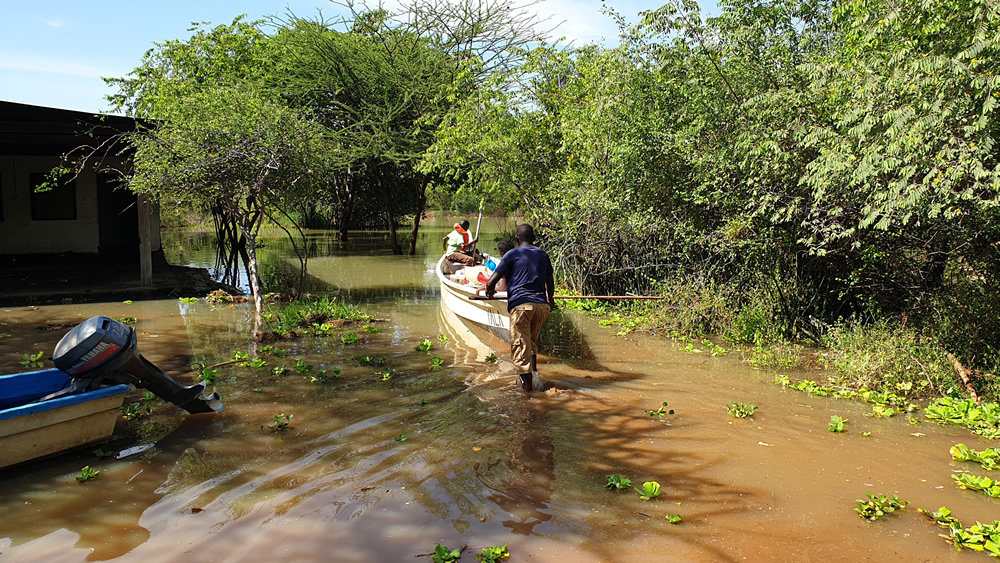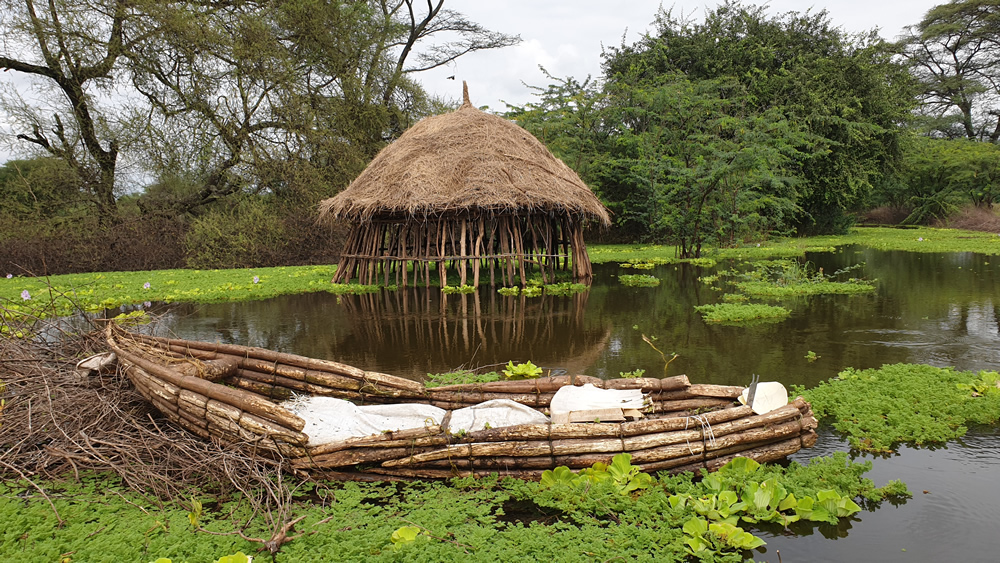It was an easy Wednesday morning when the phone call came in. I was seated in my study, pitching ideas, studying for my semester exams and trolling the net for news. The COVID-19 pandemic has us working from home and away from offices and fieldwork unless absolutely necessary. My producer, Joe, told me there was a situation developing down in Baringo that fitted the “absolutely necessary” description.
Early the next day, I packed up to leave Nairobi for the first time since March, an overnight stay. Risk assessment? Check. Equipment? Check. PPE? Check. Headphones? Check. Waterproof shoes? I forgot to buy those.
The Landcruiser meandered its way down the winding highways and picturesque scenery of Kenya’s Rift Valley. Up at Mau Summit, Mount Longonot’s imposing mass upon the lowlands reminded me of the breath-taking scenery that is Great Rift Valley’s gift to Kenya. But this marvel of nature has been sending warning signs lately. Two years ago, the ground split open at Suswa, leaving a giant crack several kilometres long and forty feet deep in some areas. Geologists wondered whether Africa was beginning to split again, whether two tectonic plates were moving away from each other. Thousands of people were forced to relocate.
This August it was the lakes in the Rift Valley, some 280 kilometres north of Nairobi, that had us heading out to investigate. Our drive to Baringo was uneventful, except for a stop in the middle of Marigat to move a tortoise off the road. The noise of passing vehicles had driven it to recoil into its shell in the middle of the highway. Baringo is teeming with wildlife.
We eventually pulled up at Kampi ya Samaki, a sleepy lakeside fishing and tourism settlement. A group of excited young men crowded the windows and aggressively tried to get our attention.
“No hotel here sir, they are all flooded. I take you somewhere else. Please. Good price”. I hear the words, but can’t figure out who spoke.
“All of them?”
“Yes. All of them. The flood is very bad. All the good hotels are gone”.
These young men are tour guides, starved of revenue since lakeside resorts in Baringo became submerged under water. One of them identifies himself as Rama. Rama says it has been months since he last had a good day’s pay. We are standing at the green gate of what would have been the entrance to Robert’s Camp. The entire facility is flooded. Every structure is under water. It was a beautiful lakeside resort with cottages and tents, camping grounds and a bar. We would probably have spent the night here. But today we will have to make do with the Tamarind Garden, situated several hundred metres away and across the road that runs alongside the lake. It is modest, clean and basic. The rooms are a bit claustrophobic, but the service more than assuages my insecurities. We retire for the night, to begin a fresh day in the early morning and really digest the extent of the damage caused by a lake that is aggressively extending its boundaries.

The sun is just rising over the hills, the rays beautifully reflecting on the calm water. It is early morning, and we have hired the services of Julius, a boatman whose thriving tour business now depends on ferrying stranded locals from one end of the lake to another, and occasional visitors like us. Dickson Lenasolio, a middle-aged local, is taking us to the place he used to call home, which he says is now all under water. As we weave through the trees and shrubs that were once Robert’s Camp’s lush gardens, I am warned not to trail my bare hands in the water. This is crocodile territory.
We move slowly along the edges of the lake. We sail past a building half submerged in water, only the green roof protruding above the morning waves. This was the fisheries department, and just beyond it was a health centre. All around me used to be dry land on which a community once thrived. There were homes, farms, schools, and hospitals. Much of that has been submerged. As we speed up, another tourist resort comes into view. The Soi Safari Lodge, a striking 74-room hotel with an Olympic-size swimming pool stands desolate and ghostly. It was deserted after the lake flooded the ground floors. I am told the owners had only recently made renovations in preparation for tourists.

We speed up across the lake, past a dead crocodile floating in the water. After about twenty minutes, the boat slows down as we approach Dickson’s former village. I can see the protruding roofs of houses where people used to live. I can make out sections of maize plantations from the extended stems of dying maize plants swaying in the waves. I can make out paddocks and homestead fences from the dangerously sagging wires and posts that are threatening to stall our boat. Dickson is now guiding us through the maze of roofs, trees and weeds, his wrinkles too prominent for one aged only 54. As he points to the spot where his house once stood, he tells us he was once a wealthy dairy farmer, before Lake Baringo swelled and swallowed up all his material wealth and he lost everything.
“I had Sahiwals [a breed of high-yield dairy cows]. I sold milk to the locals and it was good business. I would sell milk every day, and I had lots of grass in my farm”.
Dickson goes on to describe what he lost.

“My farm here was wire-fenced. We were using solar power to keep out wild animals. But when the water approached and we kept thinking it will recede, it did not, until it became impossible to retrieve the wire. Now it’s all below here, and the wire was very expensive. One roll is over 200 dollars. I fenced over 40 acres with it. My brother fenced 60. All of that is gone. It’s had to get it out because you can hardly even see the posts. These were 9-foot posts”.
“It wasn’t just me. There were other farmers who also did the business. They kept cows either for beef or milk. We suffered heavy losses. Because all the farms are now under water. We had no means of preventing it. At first, we thought we could seal the farms off. But, no. The lake kept rising night and day. Until it covered all the farms and we moved”.

Dickson says they have never seen the water levels rise like this since they were born. Not even his father, who he says is now 92. He recalls how the flooding began during the heavy rains back in March and everyone thought it would ease off with time. It did not.
“I brought down my buildings and so did my neighbours”, says Dickson. “We moved up about 800 metres. We started living there, and the water still got to us. We pulled our homes down. Now many have moved up the hill, to Marigat, Leberer, all the way up. Unfortunately, when we moved the animals up there, away from the grass they were used to, they fell sick and died”.
“Our father lived here. Our grandfathers lived here too. But now we have no hope. We don’t see the water receding because it has risen to unprecedented levels”.’
We drop Dickson off as close to his new home as possible, and he alights and wades off into the distance. He fears he may have to relocate his home for the third time.
The flooding has also cut off essential services. Power, transport, health. A building that used to be a clinic sits lonely among the tall dead trees in the still water. We watch as sick women are brought in by boat. They wade to the shore in search of medication. They will meet nurse Emily, who provides free health care in a little green tent, from where she has noticed a surge in crocodile attacks.

“We were treating burns, wounds and snake bites”, says Emily. “We also helped women with family planning and gave HIV/AIDS support. Since the flooding, our work has been affected because many people can’t get to us because they used to come on foot. Others fear travelling over water because there are crocodiles and hippos”.
Next to Emily’s small tent a group of women are sifting quality grass seeds. The seeds would have been planted on the land which is now underwater. The health facilities and grass are provided by RAE (Rehabilitation of Arid Environments), a trust that helps local people turn arid land into sustainable pasture. The social enterprise runs a project called “Nyasi ni Pesa” – grass is money – which provides the locals with indigenous species of dryland grass which can survive the area’s arid conditions. This is the grass that Dickson’s purebreds thrived on. After harvesting, RAE then buys back the seeds, giving the women and their families a healthy income too. But the whole model is now under threat.
Murray Roberts, a Kenyan of British ancestry, runs the RAE project. He has lived in Baringo his whole life, and has watched the water levels rise and rise. Roberts shows me an extraordinary family photo taken in the 90s. It’s a photo of his two sons jumping off a cliff outside his home. It appears to be at least 30 feet high. We take another boat ride to the place where the photo was taken; the entire cliff face is now below the water.

But Murray has an even bigger fear than the loss of land and livelihoods. Less than 40 kilometres south of Lake Baringo is Lake Bogoria. The highly saline lake is home to a famous colony of flamingos and is a gazetted national park. But Lake Bogoria is also rising. I learn that the Kenya Wildlife Service has moved its main gate three times, each one submerged as the lake expands. Senior KWS Warden James Kimaru has been quoted saying that the water levels increased within one month from a width of 34 km2 to 43 km2. We see one of the KWS buildings in the distance, half submerged in water. New roads into the reserve are being constructed after previous ones were also covered by the water. As the lakes expand in width, the distance between them shrinks. Murray is concerned that with both Lake Baringo and Lake Bogoria rising, the two lakes could eventually contaminate each other.
“The thing that is really worrying me about this situation is if Lake Bogoria starts flowing into Lake Baringo. What would be the outcome of that because Bogoria is a highly alkaline lake and it will be an ecological disaster. Once that water reaches Lake Baringo it will affect the fish, it will affect the bird life, it will affect the aquatic life”.

It is a concern that the Baringo County government shares. A post-floods report published in June by the Kenya Inter-Agency Rapid Assessment Mechanism concluded that the Rift Valley is becoming the most flood-prone region in Kenya. Much of that water ends up in the lakes, which inevitably swell. The report attributed the flooding to a combination of poor land use practices, deforestation and accumulation of silt. In May, the government counted over 200 deaths from flooding, with at least 800,000 people affected countrywide, Much of the destruction happened along river and lake settlements like Lake Baringo and its feeder rivers. Outside the Rift Valley, Lake Victoria was reported to have risen to its highest levels in over 50 years.
Helen Robinson, a geologist with extensive experience in East Africa, explained to me that when it is hot and dry for a long time the soils becomes so dry that they cannot absorb water. Then when it rains, huge amounts run along the surface to the rivers, then the lakes. Robinson explained that if the soils had some moisture content, much more of the rainwater would drain into the groundwater system. Trees help soils to retain moisture, but Kenya’s forest cover is only 7% of its landmass, 3 per cent less than the 10 per cent recommended by the United Nations.

All these points reinforce the concerns that human activity is contributing to the extreme changes in our climate. The UN says climate change is a reality, and that human activity is the main cause. Scientists have stressed the importance of lowering our carbon emissions to limit the impact we’re having on our planet. Robinson said that if we don’t try harder, the damage could become irreversible including melting ice at the poles, rising sea levels, more climate extremes, loss of habitats and mass extinctions.
Baringo is experiencing extreme weather changes and destruction to its habitat. But across the Rift Valley, similar swellings were recorded in Lake Nakuru and Lake Naivasha this year, and even in Lake Turkana in the north, with the varying levels of destruction pointing to a pattern. Whatever the causes, it is a race for survival, and at the moment, nature is winning.








